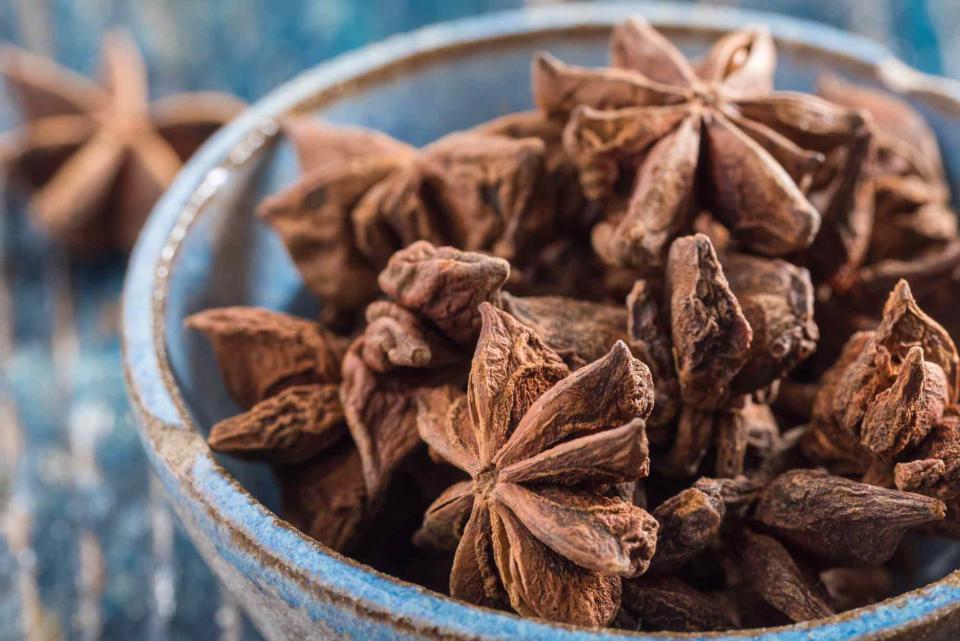Star Anise vs. Anise Seed: How Are They Different?
These two spices are often mistaken for each other, but they couldn't be more different.

Michelle Arnold/EyeEm/Getty Images
Star anise vs. anise seed: What's the difference? Both spices bear the word "anise" in their name and have a licorice-like flavor, but the similarities stop there. In fact, star anise and anise seed are derived from completely different plants that originate from opposite sides of the world. In some recipes, they can be substituted for each other, but there are some key differences to keep in mind. Below, we explain the differences between star anise and anise seed to help you navigate your spice cabinet.
Related: Spice Substitutes to Save Your Recipes in a Pinch
What Is Star Anise?
Star anise comes from the fruit of the Chinese evergreen tree, which is found in Southeast Asia. It's named for the unique star-shaped pods from which the spice is derived. Each pod contains one seed and both the seed and pod are used in cooking. The essential oil anethole gives star anise its characteristic licorice-like flavor—which is much more bitter than anise seed. You can find star anise whole or ground in the spice aisle.
Related: Chinese-Style Bone-In Chicken Noodle Soup with Star Anise and Ginger
What Is Anise Seed?
Anise seed (sometimes called "aniseed") is believed to have been first cultivated in Egypt and the eastern Mediterranean. It's derived from the anise plant, a herb in the parsley family that's native to that region. The seeds are small and oblong, similar to fennel seeds. Like star anise, anise seed gets its licorice-like flavor from anethole, but it has a much tamer flavor. Anise seed is often used in liqueurs, like ouzo, sambuca, and absinthe. It can be used in both sweet and savory recipes.
Related: Apple-Anise Pizza
How to Use Star Anise
Star anise is often used in Chinese, Vietnamese, and Indian cuisine. Its bitter flavor lends itself well to spice blends like Five-Spice Powder and garam masala. Whole star anise can be added to stews, curries, and soups to impart flavor (much like a bay leaf). The spice can also be purchased ground or ground with a mortar and pestle to increase the potency of the licorice-like flavor in baked goods, rubs, and spice blends. Star anise is often used in popular dishes like pho, biryani, and chai and it adds warm spice to both sweet and savory dishes.
Related: Pork Skewers with Five-Spice Hoisin Sauce
How to Use Anise Seed
Anise seed is primarily used to flavor baked goods such as Italian biscotti, pies, and candies, but it is also used to season savory foods like Italian sausage. Occasionally, anise seed extract or anise liqueur is added to drinks to lend depth and a biting licorice flavor. Anise seed pairs well with pork, duck, fish, fruit, and chocolate and is often combined with clove, mace, tarragon, and caraway. Commercially, anise seed is used to scent soaps, skin creams, candles, and mouth fresheners among other things.
Related: Cafe Anise Ice Cream
Substitutes for Star Anise and Anise Seed
Their similar licorice-like flavor makes these two natural substitutes for each other. However, because star anise has a much stronger flavor, you'll need to halve the amount when substituting it for anise seed. Likewise, use twice as much anise seed when substituting for star anise. You can also use extracts to add licorice flavor to baked goods and in recipes.
While star anise's flavor profile is more bitter than anise seed, their signature licorice flavor will come through no matter which one you use. When in doubt, fennel makes a great substitute for either of these spices.
Related: Fennel & Orange Shortbread
Where to Buy Star Anise and Anise Seed
You can buy star anise and anise seed at your local grocery store. If you can’t find them there, check a specialty grocery store. Mediterranean grocery stores may to carry anise seed, and any Asian supermarket will likely stock star anise.
Once you’ve purchased these spices, keep them in a cool, dry place to make the most out of their shelf life. Stored this way, they can keep well for three to four years. If you open the spices and they don't smell strongly or the flavor is weak, it's a good idea to replace them.
Related: How to Keep Spices Fresh Longer to Make Cooking So Much Easier
Frequently Asked Questions
What is the difference between anise and fennel?
Like star anise and anise seed, fennel has a licorice-like flavor derived from the aromatic compound anethole. Fennel, however, is an edible bulb with a milder, less sweet, and more delicate flavor than both anise seed and star anise.
Can I grind star anise pods whole?
Yes. The entire pod is edible and both the inner seeds and the woody star-shaped pod impart flavor.
Should I remove whole star anise pods from soups and broths before serving?
Yes. While the star-shaped pods are edible, they remain quite hard—even after hours of stewing. If left in, they could pose a choking hazard or be damaging to teeth and dental work.
For more Better Homes & Gardens news, make sure to sign up for our newsletter!
Read the original article on Better Homes & Gardens.

